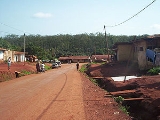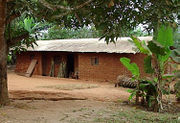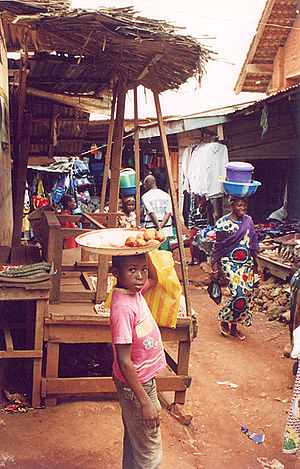
Abong-Mbang
Encyclopedia
Abong-Mbang is a town and commune
in the East Province
of Cameroon
. Abong-Mbang is located at a crossroads of National Route 10 and the road that leads south to Lomié
. Yaoundé
, the capital of Cameroon, is 311 km (193 mi) to the west, and Bertoua
, the capital of the East Province, lies 27 km (17 mi) to the east. From Ayos
, at the border in the Centre Province
145 km (90 mi) from Abong-Mbang, the tar on National Route 10 ends and a dirt road begins. Abong-Mbang is the seat of the Abong-Mbang sub-division and the Haut-Nyong division. The town is headed by a mayor. Gustave Mouamossé has held the post since August 2002. Abong-Mbang is site of one of the East Province's four Courts of First Instance and a prefectural prison. The population was estimated at 18,700 in 2001.
According to oral traditions of the Kwassio and Bakola peoples, Abong-Mbang was settled when the Maka-Njem peoples moved northwest from the Great Lakes
region of the Congo River
. They encountered Pygmy hunter-gatherers and requested their aid as guides through the region. Some of the migrants settled in the vicinity, which they called Bung-Ngwang ("bathing area in the Nyong River"). When Europeans arrived in the 19th century, this name was changed to Abong-Mbang. Some migrants continued westward in search of salt; they became the Kwassio and Bakola of Cameroon's coast. German colonisers
moved into the area in the late 19th century. They used the Nyong River as a means to reach the wild rubber growing farther inland. The Germans built a fort and other military and administrative buildings in the town. The fort is today a prefectural prison, and the other buildings serve similar administrative functions. The French took over in 1919 following Germany's defeat in World War I.
 Abong-Mbang is the main settlement of the Maka people
Abong-Mbang is the main settlement of the Maka people
, a group who speak a Bantu
language of the same name. Much of the population farms; important crops include bananas, cocoa, corn, groundnuts, tomatoes, and tubers. Shifting cultivation
with no fertiliser is the primary method of agriculture. Baka
hunter-gatherers live in the surrounding forests. Since colonial times, the government has attempted to better integrate this group into Cameroonian society. Abong-Mbang is part of the Doumé-Abong-Mbang diocese of the Roman Catholic Church. The church estimates that 46.7% of the population is Roman Catholic.
Since Francophone Cameroun's independence in 1960, Abong-Mbang has become an important centre of commerce for the East Province. This has led to a cosmopolitan influx of immigrants from outside the Maka area. An estimated 99% of males and 95% of females speak French. However, among traders, Ewondo
is the lingua franca of choice: 72% use Ewondo but only 48% use French in market situations. By the late 1970s, the government had zoned large areas of the surrounding forest for timber exploitation. Most timber and bush meat traffic from the East Province passes through the town. Union Abong-Mbang FC is the local football (soccer) team. The town often suffers prolonged cuts to electric power, which the utility company, AES-SONEL, blames on an aging power plant. On 17 September 2007, violent protests against the cuts ended with two protesters dead and 10 others seriously injured.
 Abong-Mbang lies on the South Cameroon Plateau
Abong-Mbang lies on the South Cameroon Plateau
, approximately 700 metres above sea level. The soils are red. The Boumba, Dja
, and Nyong
rivers rise in the Abong-Mbang region. The Nyong forms the town's northern border and is navigable for about 160 km (100 mi) to Mbalmayo
in the Centre Province. The area along the Nyong consists of swampy forests that support populations of raffia palm
, such as Raphia montbuttorum. The area surrounding the town consists of secondary-growth forest of semi-deciduous
trees, particularly Stertuliaceae and Ulmaceae
; the primary-growth forest has been removed for logging and farming. In some areas, the forests are further degraded and home to other forms of vegetation. The Abong-Mbang Forest Reserve is north of the town. Local wildlife includes populations of Western lowland gorilla
and forest elephant
s. An estimated 100 elephants lived in the Abong-Mbang Forest Reserve in 1998. The Ntimbe Caves are 18 km (11 mi) south of the town.
Communes of Cameroon
The Communes of Cameroon are the third-level units of administration in Cameroon. The communes are organised by arrondissements of the Divisions of Cameroon of each province....
in the East Province
East Province (Cameroon)
The East Region occupies the southeastern portion of the Republic of Cameroon. It is bordered to the east by the Central African Republic, to the south by Congo, to the north by the Adamawa Region, and to the west by the Centre and South Regions...
of Cameroon
Cameroon
Cameroon, officially the Republic of Cameroon , is a country in west Central Africa. It is bordered by Nigeria to the west; Chad to the northeast; the Central African Republic to the east; and Equatorial Guinea, Gabon, and the Republic of the Congo to the south. Cameroon's coastline lies on the...
. Abong-Mbang is located at a crossroads of National Route 10 and the road that leads south to Lomié
Lomié
Lomié is a town in the Lomié District in the Upper Nyong division of the East Province of Cameroon. An article in the Mail & Guardian Online describes it as having "no telephone connection to the outside world, and a single access road that is little more than a forest trail".In fact Lomié has been...
. Yaoundé
Yaoundé
-Transportation:Yaoundé Nsimalen International Airport is a major civilian hub, while nearby Yaoundé Airport is used by the military. Railway lines run west to the port city of Douala and north to N'Gaoundéré. Many bus companies operate from the city; particularly in the Nsam and Mvan neighborhoods...
, the capital of Cameroon, is 311 km (193 mi) to the west, and Bertoua
Bertoua
Bertoua is the capital of the Eastern Province of Cameroon and has a population of 88,462 . It is home to an airport and Mission Cameroon of Polish Dominican Order.-External links:*...
, the capital of the East Province, lies 27 km (17 mi) to the east. From Ayos
Ayos
-References:* * - Thèse de Donation Avele, Université Montesquieu Bordeaux IV * Charles Nanga, , Mémoire ENA....
, at the border in the Centre Province
Centre Province
The Centre Region occupies 69,000 km² of the central plains of the Republic of Cameroon. It is bordered to the north by the Adamawa Region, to the south by the South Region, to the east by the East Region, and to the West by the Littoral and West Regions. It is the second largest of...
145 km (90 mi) from Abong-Mbang, the tar on National Route 10 ends and a dirt road begins. Abong-Mbang is the seat of the Abong-Mbang sub-division and the Haut-Nyong division. The town is headed by a mayor. Gustave Mouamossé has held the post since August 2002. Abong-Mbang is site of one of the East Province's four Courts of First Instance and a prefectural prison. The population was estimated at 18,700 in 2001.
According to oral traditions of the Kwassio and Bakola peoples, Abong-Mbang was settled when the Maka-Njem peoples moved northwest from the Great Lakes
African Great Lakes
The African Great Lakes are a series of lakes and the Rift Valley lakes in and around the geographic Great Rift Valley formed by the action of the tectonic East African Rift on the continent of Africa...
region of the Congo River
Congo River
The Congo River is a river in Africa, and is the deepest river in the world, with measured depths in excess of . It is the second largest river in the world by volume of water discharged, though it has only one-fifth the volume of the world's largest river, the Amazon...
. They encountered Pygmy hunter-gatherers and requested their aid as guides through the region. Some of the migrants settled in the vicinity, which they called Bung-Ngwang ("bathing area in the Nyong River"). When Europeans arrived in the 19th century, this name was changed to Abong-Mbang. Some migrants continued westward in search of salt; they became the Kwassio and Bakola of Cameroon's coast. German colonisers
Colonialism
Colonialism is the establishment, maintenance, acquisition and expansion of colonies in one territory by people from another territory. It is a process whereby the metropole claims sovereignty over the colony and the social structure, government, and economics of the colony are changed by...
moved into the area in the late 19th century. They used the Nyong River as a means to reach the wild rubber growing farther inland. The Germans built a fort and other military and administrative buildings in the town. The fort is today a prefectural prison, and the other buildings serve similar administrative functions. The French took over in 1919 following Germany's defeat in World War I.

Maka people
The Maka or Makaa are an ethnic group inhabiting the southern rain forest zone of Cameroon. They live primarily in the northern portions of the Upper Nyong division of Cameroon's East Province. Major Maka settlements include Abong-Mbang, Doumé, and Nguélémendouka...
, a group who speak a Bantu
Bantu languages
The Bantu languages constitute a traditional sub-branch of the Niger–Congo languages. There are about 250 Bantu languages by the criterion of mutual intelligibility, though the distinction between language and dialect is often unclear, and Ethnologue counts 535 languages...
language of the same name. Much of the population farms; important crops include bananas, cocoa, corn, groundnuts, tomatoes, and tubers. Shifting cultivation
Shifting cultivation
Shifting cultivation is an agricultural system in which plots of land are cultivated temporarily, then abandoned. This system often involves clearing of a piece of land followed by several years of wood harvesting or farming, until the soil loses fertility...
with no fertiliser is the primary method of agriculture. Baka
Baka (Cameroon and Gabon)
The Baka, known in the Congo as Bayaka , are an ethnic group inhabiting the southeastern rainforests of Cameroon, northern Republic of Congo, northern Gabon, and southwestern Central African Republic. They are sometimes called a subgroup of the Twa, but the two peoples are not closely related...
hunter-gatherers live in the surrounding forests. Since colonial times, the government has attempted to better integrate this group into Cameroonian society. Abong-Mbang is part of the Doumé-Abong-Mbang diocese of the Roman Catholic Church. The church estimates that 46.7% of the population is Roman Catholic.
Since Francophone Cameroun's independence in 1960, Abong-Mbang has become an important centre of commerce for the East Province. This has led to a cosmopolitan influx of immigrants from outside the Maka area. An estimated 99% of males and 95% of females speak French. However, among traders, Ewondo
Ewondo language
Ewondo is the language of the Ewondo people of Cameroon. The language had 577,700 native speakers in 1982. Ewondo is a trade language. Dialects include Badjia , Bafeuk, Bamvele , Bane, Beti, Enoah, Evouzok, Fong, Mbida-Bani, Mvete, Mvog-Niengue, Omvang, Yabekolo , Yabeka, and Yabekanga...
is the lingua franca of choice: 72% use Ewondo but only 48% use French in market situations. By the late 1970s, the government had zoned large areas of the surrounding forest for timber exploitation. Most timber and bush meat traffic from the East Province passes through the town. Union Abong-Mbang FC is the local football (soccer) team. The town often suffers prolonged cuts to electric power, which the utility company, AES-SONEL, blames on an aging power plant. On 17 September 2007, violent protests against the cuts ended with two protesters dead and 10 others seriously injured.

South Cameroon Plateau
The South Cameroon Plateau or Southern Cameroon Plateau is the dominant geographical feature of Cameroon. The plateau lies south of the Adamawa Plateau and southeast of the Cameroon Range. It slopes south and west until giving way to the Cameroon coastal plain in the southwest and the Congo River...
, approximately 700 metres above sea level. The soils are red. The Boumba, Dja
Dja River
The Dja River is a stream in west-central Africa. It forms part of Cameroon–Republic of Congo border and has a course of roughly 450 miles ....
, and Nyong
Nyong River
The Nyong is a river in Cameroon. The river flows approximately 640 km to empty into the Gulf of Guinea.-Transport:The town of Mbalmayo, which has a railhead, lies on the north bank of this river. The towns of Akonolinga and Abong-Mbang also lie on it....
rivers rise in the Abong-Mbang region. The Nyong forms the town's northern border and is navigable for about 160 km (100 mi) to Mbalmayo
Mbalmayo
Mbalmayo, chef-lieu du département du Nyong –et – So’o est une ville d’environ 120 000 habitants sur les bords du Fleuve Nyong, située à 38km de Yaoundé....
in the Centre Province. The area along the Nyong consists of swampy forests that support populations of raffia palm
Raffia palm
The Raffia palms are a genus of twenty species of palms native to tropical regions of Africa, especially Madagascar, with one species also occurring in Central and South America. They grow up to 16 m tall and are remarkable for their compound pinnate leaves, the longest in the plant kingdom;...
, such as Raphia montbuttorum. The area surrounding the town consists of secondary-growth forest of semi-deciduous
Semi-deciduous
Semi-deciduous is a botanical term which refers to plants that lose part of their foliage, also Semi-deciduous plants can mean, that plants can lose their foliage for a very short period, when old leaves fall off and new foliage growth is starting. This phenomenon occurs in tropical and...
trees, particularly Stertuliaceae and Ulmaceae
Ulmaceae
Ulmaceae is a family of flowering plant that includes the elms , and the zelkovas . Members of the family are widely distributed throughout the north temperate zone, and have a scattered distribution elsewhere except for Australasia.The family was formerly sometimes treated to include the...
; the primary-growth forest has been removed for logging and farming. In some areas, the forests are further degraded and home to other forms of vegetation. The Abong-Mbang Forest Reserve is north of the town. Local wildlife includes populations of Western lowland gorilla
Western Lowland Gorilla
The western lowland gorilla is a subspecies of the western gorilla that lives in montane, primary, and secondary forests and lowland swamps in Angola, Cameroon, Central African Republic, Congo, Democratic Republic of the Congo, Equatorial Guinea and Gabon. It is the gorilla usually found in zoos...
and forest elephant
African Forest Elephant
The African Forest Elephant is a forest dwelling elephant of the Congo Basin. Formerly considered either a synonym or a subspecies of the African Savanna Elephant , a 2010 study established that the two are distinct species...
s. An estimated 100 elephants lived in the Abong-Mbang Forest Reserve in 1998. The Ntimbe Caves are 18 km (11 mi) south of the town.

